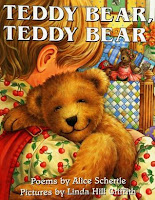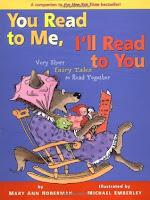 |
| From: Principalj.blogspot.com |
If you’ve been following my blog AT ALL, you know I am a big (huge, total) fan of reading poetry aloud. Heck, I even wrote a book about it (Poetry Aloud Here)! I believe it is the ideal way of sharing poetry with children. It builds on their oral language expertise, expands their listening skills, invites participation, models pronunciation and diction, demonstrates fluent reading, and takes very little classroom time. I could go on and on. Plus, poets always tell me that their poetry is meant to be HEARD. They choose each word, plan each line and stanza, and craft each poem for the auditory impact, as well as for meaning and emotion. But it’s so basic, that I find people often dismiss this simple practice. Please DON’T!
One of the reasons I love this new movement of inviting children to read to pets (therapeutic dogs and even stuffed animals) is that it focuses on reading aloud. It provides such a comfortable context for kids to practice their reading aloud—especially kids who are lacking in confidence or still struggling with reading easily and smoothly. Why not incorporate poetry into this practice?
When it comes to reading poetry aloud to kids, just about any book of poetry will work—particularly if YOU enjoy it and if it’s a topic with kid appeal. Instant success! But there are some books of poetry that are planned for this purpose—designed to be read aloud and shared with a partner or group. I thought it might be fun to pull a list of those together to share here. Here are 20 books with poems that beg to be read aloud—and some include action and motions, always fun!
Poetry collections designed for reading aloud
- Ada, Alma Flor, and Campoy, Isabel, comp. 2003. Pio Peep! Traditional Spanish Nursery Rhymes. New York: HarperCollins.
- Ada, Alma Flor and Campoy, Isabel, comp. 2010. Muu, Moo! Rimas de animales/Animal Nursery Rhymes. New York: Rayo/HarperCollins.
- Bagert, Brod. 2007. Shout! Little Poems that Roar. New York: Dial.
- Calmenson, Stephanie. 2005. Kindergarten Kids: Riddles, Rebuses, Wiggles, Giggles, and More! New York: HarperCollins Publishers.
- Crews, Nina. 2004. The Neighborhood Mother Goose. New York: Greenwillow.
- Crews, Nina. 2011. Neighborhood Sing Along. New York: HarperCollins.
- Dotlich, Rebecca Kai. 2004. Over in the Pink House: New Jump Rope Rhymes. Honesdale, PA: Wordsong/Boyds Mills Press.
- Franco, Betsy. 2004. Counting Our Way to the 100th Day. New York: Margaret K. McElderry Books.
- Hale, Glorya, ed. 1997. Read-aloud Poems for Young People: An Introduction to the Magic and Excitement of Poetry. New York: Black Dog & Leventhal.
- Hoberman, Mary Ann. 2001. You Read to Me, I’ll Read to You; Very Short Stories to Read Together. Ill. by Michael Emberley. Boston: Little, Brown.
- Hoberman, Mary Ann. 2004. You Read to Me, I’ll Read to You; Very Short Fairy Tales to Read Together. Ill. by Michael Emberley. Boston: Little, Brown.
- Hoberman, Mary Ann. 2005. You Read to Me, I’ll Read to You; Very Short Mother Goose Tales to Read Together. Ill. by Michael Emberley. Boston: Little, Brown.
- Hoberman, Mary Ann. 2007. You Read to Me, I’ll Read to You; Very Short Scary Tales to Read Together. Ill. by Michael Emberley. Boston: Little, Brown.
- Hopkins, Lee Bennett, comp. 1998. Climb Into My Lap: First Poems To Read Together. New York: Simon & Schuster.
- Katz, Bobbi. 2001. A Rumpus of Rhymes: A Book of Noisy Poems. New York: Dutton.
- Mora, Pat. 1996. Uno Dos Tres. New York: Clarion.
- Newcome, Zita. 2000. Head, Shoulders, Knees, and Toes and Other Action Rhymes. Somerville, MA: Candlewick.
- Orozco, José Luis. 2002. Diez Deditos: Ten Little Fingers and Other Play Rhymes and Action Songs from Latin America. New York: Dutton.
- Schertle, Alice. 2003. Teddy Bear, Teddy Bear. New York: HarperCollins.
- Sierra, Judy. 2005. Schoolyard Rhymes: Kids’ Own Rhymes for Rope Skipping, Hand Clapping, Ball Bouncing, and Just Plain Fun. New York: Knopf.



And for a more advanced group, don’t forget to try poetry for multiple voices. This takes a bit more planning, but can be so enjoyable and meaningful!
Poetry for multiple voices
- Fleischman, Paul. 1985. I Am Phoenix: Poems for Two Voices. New York: Harper & Row.
- Fleischman, Paul. 1988. Joyful Noise: Poems for Two Voices. New York: Harper & Row.
- Fleischman, Paul. 2000. Big Talk: Poems for Four Voices. Somerville, MA: Candlewick.
- Franco, Betsy. 2009. Messing Around the Monkey Bars and other School Poems for Two Voices. Ill. by Jessie Hartland. Somerville, MA: Candlewick.
- Gerber, Carole. 2013. Seeds, Bees, Butterflies and More! Poems for Two Voices. New York: Holt.
- Harrison, David L. 2000. Farmer’s Garden: Rhymes for Two Voices. Honesdale, PA: Wordsong/Boyds Mills.
- Heard, Georgia. 1992. Creatures of Earth, Sea, and Sky. Honesdale, PA: Wordsong/ Boyds Mills.
- Pappas, Theoni. 1991. Math Talk: Mathematical Ideas in Poems for Two Voices. San Carlos, CA: Wide World Publishing/Tetra.
For more tips on reading poetry aloud, check out Paige Bentley-Flannery’s post at the ALSC blog here.
Last week, Janet (Wong) and I were so pleased have our post featured at the Nerdy Book Club blog. We featured our latest project of course—PET CRAZY, which is so fun to read aloud, especially with pets or stuffed animals. It even has a poem about reading to a pet—Liz Steinglass’s awesome poem, “Book Hound” about reading to a dog named Ruby. Here it is:
Janet wrote a wonderful response poem to Liz’s poem about reading to a rabbit!
And when Janet and I found a “Reading Rabbit” that you can record a message on (to have the Rabbit “speak” to you), we went bananas! (Or should I say, “we went carrots!”?). We bought that Reading Rabbit, recorded a special message, and in honor of our pet theme, we are sending that Reading Rabbit—to one of the people who helped us spread the word about our Nerdy Book Club post and our PET CRAZY book. After gathering all those names (thank you ALL so much!), we drew one name and the winner of our special Reading Rabbit is…..
Allison Jackson
3rd grade teacher
Waggoner Elementary School
Tempe, Arizona
Congratulations, Allison! We’ll be mailing our Reading Rabbit to you shortly! We hope you and your students have a great time reading poetry aloud to RR—and we’d love to see some photos, if you have time!
Meanwhile, join the rest of the Poetry Friday crew over at Today’s Little Ditty where the wonderful Michelle Heidenrich Barnes is hosting our gathering!
Meanwhile, join the rest of the Poetry Friday crew over at Today’s Little Ditty where the wonderful Michelle Heidenrich Barnes is hosting our gathering!




















